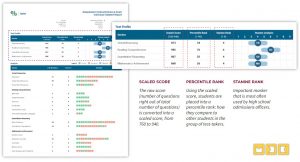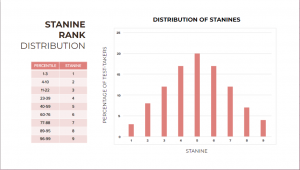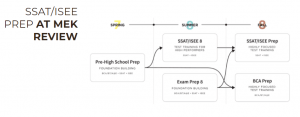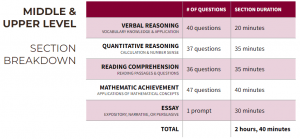
Webinar Recap: Reading Your ISEE Score Report
Webinar Recap: Reading Your ISEE Score Report
On Tuesday, February 22nd, MEK Review hosted a free webinar designed to help parents learn how to read their child’s ISEE score report. There was a great turn out for the event, and we want to thank all who attended and participated.
For parents who are new to high school admissions tests, we broke down how the ISEE is structured and gave detailed instructions for how to read your child’s ISEE score report . We also answered your questions about how the ISEE affects high school admissions and how MEK can help your child reach their goal score.
But if you were unable to attend, don’t worry!
Here is a quick recap of what you missed along with expert recommendations for next steps:
1. What is the ISEE?
The ISEE is an admissions test used by private high schools to differentiate between otherwise similar candidates using a “level” playing field. ISEE test-takers are ambitious middle schoolers, who rank among the best in their class, making this a very competitive exam.
The test measures verbal reasoning, reading comprehension, written expression, and mathematical skills. These are skills that high schools consider to be the essential foundation of academic success.
The ISEE is offered to three levels of students:
-
- Lower Level, for applicants to grades 5-6
- Middle Level, for applicants to grades 7-8
- Upper Level, for applicants to grades 9-12
The test is given once in the summer, once in the fall, and once in the spring. Students can take the test once per season for a total of up to three times.
2. How is the ISEE structured?
The following image shows a section break down of what skills are tested on the upper and middle level ISEE tests, the number of questions per section, and how many minutes students get for each section.
*It’s important to note the time limits for each section as learning how to answer questions and write essays in a timed environment is an essential part of test prep.
3. What specific skills are tested?
VERBAL REASONING
The Verbal Reasoning section of the test is comprised of half synonym questions and half sentence completions. Many of the most challenging words on this section may be words students have never seen before. These questions test students’ abilities to define common and uncommon words through prefixes, root words, context clues, and verbal reasoning.
READING COMPREHENSION
Depending on their level, students must read 5-9 reading passages and answer a series of questions for each. Questions range from basic fact questions that require simple, direct reference to the evidence in the passage to more complex purpose or inference questions.
QUANTITATIVE REASONING
This section is comprised of multiple-choice problems that are less calculation-focused and center more on mathematical thinking, such as estimating and comparing values or drawing conclusions based on presented information. Students are assessed on their reasoning skills rather than specific math content. On the lower level exam, all questions in this section are word problems. While the middle level and upper level exams contain a mix of word problems and quantitative comparisons.
MATHEMATIC ACHIEVEMENT
Students are assessed on mathematical concepts and calculation skills learned in school. All problems are multiple choice and require calculations as well as knowledge of grade-appropriate terminology and content.
ESSAY
The tests use a variety of different prompt types, such as expository, persuasive, and narrative, that require creativity and structure/organization. The essay is unscored. However, it is up to the discretion of the school as to how they want to use the essay. Some schools will use the essay as a writing sample in your child’s formal admissions package, while some schools might not use it at all.
4. What test-prep skills does my child need to be successful?
For many students, the ISEE is one of their first times in a time-pressured testing environment. That’s why on test-day, test taking skills often serve to be just as important as content-based skills.
Students need:
- MENTAL FOCUS to identify question types and execute the appropriate strategies
- ACUITY & AGILITY for tackling difficult problems in creative ways
- CONFIDENCE, which helps reduce burnout and anxiety from facing challenging problems
- ENDURANCE to maintain focus throughout the length of the entire test
- TEST-TAKING MATURITY to remain unfazed by difficult questions
- HEALTHY COPING MECHANISMS for test-day anxiety
These skills will help your child be successful on test day!
5. How do I read my child’s ISEE score report?
Your child’s ISEE score is broken down into three sections: scaled score, percentile rank, and stanine rank. The image below shows an example of where you can find these sections on your child’s score report.

The scaled score is calculated using your child’s raw score. The raw score is the number of questions your child got correct out of the total number of overall questions. That raw score is then converted into a scaled score, from 760 to 940.
The scaled score determines your child’s percentile rank. This number represents where your child stands compared to other test-takers in their level.
The stanine score is calculated by dividing the entire range of student percentile ranks into 9 segments, with 5 set as the midpoint. High school admissions officers use the stanine score to determine entrance to the high school to which your child is applying. Below is an image showing the distribution of stanines across the percentage of test-takers.

All together, scaled score, percentile rank, and stanine rank comprise your child’s score on the ISEE and each serve an important purpose in the high school admissions process.
If you took an ISEE simulation test with MEK, you should have received a score report. Below is an example.

Every MEK ISEE score report includes your child’s scaled score and percentile rank. These numbers are outlined in red on the exemplar score report.
Unlike the SAT, which approximately 90% of US high school students take, the most ambitious middle schoolers seeking entrance to elite high schools take the SSAT/ISEE. These students are the best and the brightest. Therefore, in order for students to be competitive, regardless of stanine or target school, they need to shoot for a perfect score.
6. Aside from the ISEE, what else does my child need when applying to elite high schools?
The admissions requirements differ from high school to high school. But some of the most common application requirements are:
- Student Statement
- Parent Statement
- School Transcripts
- Letters of Recommendation
- Guidance Counselor / Principal
- English Teacher
- Math Teacher
- Science Teacher
- Personal Recommendation
- Activities List
- Interview
Check with the school to which you are applying for more specific information about what they require your child to include in their application package.
7. How will MEK help my child prepare for the ISEE?
The ISEE is most likely the first time your child has taken a high stakes exam. The test itself is cumulative in nature and tests skills that your child should have developed over years of classroom instruction. At MEK Review, we know that students who are starting out on their test prep journey need constant reinforcement and ample time to master key classroom skills.
That’s why MEK focuses our test prep on building your child’s content knowledge, test-taking skills, and mindset. How does MEK help your child build these skills? Check out the chart below for a detailed break down of the MEK method.
| English | Math | MEK Tools |
|---|---|---|
| Effective reading skills for full reading comprehension | Full coverage of every Math concept | Targeted practice |
| Complete coverage of ISEE vocabulary words | Specific strategies for high yield questions | Weekly practice tests to boost stamina for difficult questions and situations |
| Investigative skills to deduce meanings of words in context | Essential Math skills to boost score AND school grades | Constant maintenance of rigor to address non-linear improvement trends |
Through a structured practice routine, facilitated by Canvas Learning Management Platform, students develop a strong work ethic. This translates into consistent performance and improvement toward goal scores!
8. When does ISEE test prep begin?
At MEK, we believe that sooner is always better. Check out the graphic below to see a timeline of our Pre-High School Prep program.

MEK’s Pre-High School Prep program starts for students in spring of 7th grade and takes them through fall of 8th grade. Students who complete Pre-High School Prep can move on to SSAT/ISEE 8 or BCA Prep depending on their goals. While students who begin with Exam Prep 8 in the summer before 8th grade can move on to BCA Prep or SSAT/ISEE Prep in the fall.
No matter where your child begins in the Pre-High School program, each course builds on the one before it, so that students have a strong foundation for success by test day.
Next Steps
This is just a small slice of everything we covered at the webinar! But if you want to register for any of our Pre-High School courses, the first step is signing up for an evaluation.
MEK’s evaluation tests the same skills that are the basis for tough high school admissions exams. Based on your child’s score, we place them in the program that best fits their needs and goals. And set them up with an individualized plan for success!
Contact us today to get started! We can’t wait to hear from you.




